The Christian visual tradition is perhaps the richest in the world, replete with motifs or visual formulas of tremendous iconic power. Two of these visual formulas, dating from very early in Christian visual history, are the Crucifix—showing Christ dead on a Roman cross—and the Resurrection—showing Christ ascended from the grave. Both of these visual formulas are often strikingly simple and mathematical: the first seems to show Jesus pinioned against a grid or coordinate plane, while the second often shows Jesus inscribed within an oval or circle. From such a simple, symbolic core have emerged thousands of images in hundreds of regions, each “speaking” the gospel narrative to a different audience. In Renaissance Italy, artists like Raphael used the “Crucifixion” formula to make paintings of beautiful, serene melancholy. Meanwhile, the Kongo peoples of Angola, Africa, developed crucifix forms of raw, distortive power.
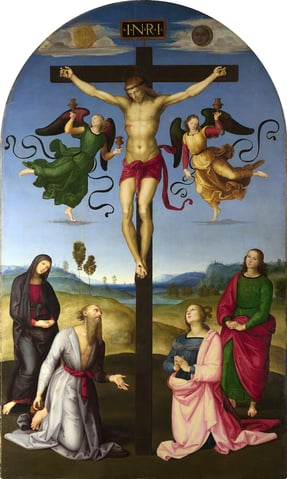
Raphael, Mond Crucifixion, 1503 / Public domain via Wikimedia Commons
In this essay, however, I don’t wish to focus on elaborate regional variations of these iconic Christian scenes. Instead, I want to emphasize the simplicity of the visual formulas that underpin them. It was this very simplicity that resonated deeply with ancient indigenous symbol systems, making the Christian imagery brought by missionaries seem like natural extensions of existing visual vocabularies. Through these remarkable harmonies, we can glimpse God’s providence for entire people groups, and we can experience the deep unity shared by all human beings made in God’s image and created for relationship with Him.
Central America and the Four Axes of the Universe
In their wonderful recent book Guadalupe and the Flower World Prophecy, Joseph and Monique Gonzalez have shown how a four-pointed diagram connecting the breadth of the world with both the heavens and the underworld had been an important symbol in indigenous Mesoamerican culture. Often closely resembling a cross, this diagram consisted of a vertical axis that reached from the underworld to the heavens and a horizontal axis that reached the edges of the earth. This diagram, in sum, functioned as a map of the universe, tracing the relationship between mortals and gods. It marked sacred places in ancient Central America, and it was elaborated into different forms over the centuries, perhaps even shaping temple architecture.
Interestingly, Christian mystics and scholars unaware of ancient Central American tradition have long noted how the Christian crucifix resonates with almost the same meanings. For example, in the 4th century, St. John Chrysostom argued that the vertical orientation of the cross symbolized the lifting of sinners to heavenly virtue. During the 1600s, in response to the Jansenist heresy, orthodox Christians insisted that the spread arms of the crucified Jesus had always symbolized the worldwide embrace of Christ. It seems that the same basic cosmic intuition, using a cross form to connect heavenly heights, sinful depths, and the far corners of creation, was anciently manifest in very different parts of the world!
In fact, this deep harmony between the spiritual intuitions of both early Christians and the people of ancient Mesoamerica helps explain why the Christian crucifix became such a powerful symbol among newly evangelized Mesoamerican Christians in the 16th century. One of the most iconic artworks from this period, in fact, is the “black” Christ of Esquipulas—a crucifix sculpture of mysterious origin that inspired tremendous devotion among the faithful of what is today called Guatemala. This dark-skinned sculpture simultaneously embodied Guatemalan cruciform symbolism and the historical sacrifice of Christ. According to tradition, it was also found in a sacred cave—and the mouths of sacred caves were often marked with the traditional four points of the ancient Mesoamerican cruciform motif.
Africa and the Four Moments of the Sun
In sub-Saharan Africa, meanwhile, the Christian crucifix also seemed to tap into deep memories and resonances. Already in sub-Saharan Africa, before the arrival of Christian evangelists, there had evolved a symbol called the “four moments of the sun,” which sometimes resembled a Roman cross. This symbol literally marked the position of the sun at four cardinal moments in the day, understood as dawn, noon, dusk, and midnight. But the symbol had greater meaning. As in many cultures, the day/night cycle was understood to be congruent to both the human life cycle and the cosmic cycle of birth, flourishing, death and rebirth. In addition, the intersection of lines connecting these four points could symbolize the meeting of the earthly and spirit worlds.
When the Christian crucifix was introduced to sub-Saharan Africa, bearing on its surface the form of a killed and resurrected god, it must have spoken immediately and deeply to the local people, touching on fundamental beliefs. Here, the earthly world and spirit world literally met in the form of the Incarnate Savior, which was displayed precisely where the lines crossed. (In fact, in some African sculptures, the cross is omitted so that Jesus’s body, alone, proclaims the intersection of the earthly and divine planes.) Meanwhile, Jesus’s execution (and implied resurrection) was a rich and powerful symbol of the life cycle itself, lifted to the divine plane in a gesture of unbelievable compassion and profundity.
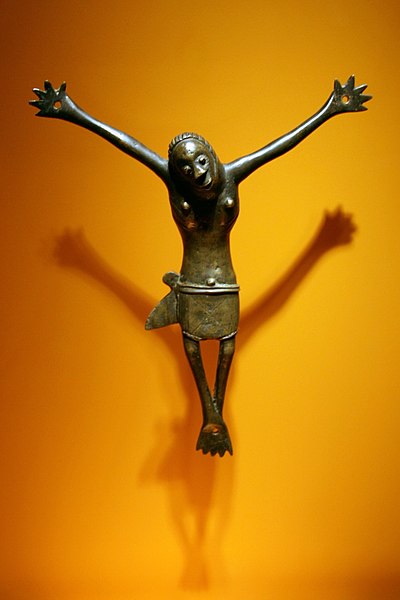 Kongo artist, Crucifix, Angola, 17th c. / Cliff1066, CC BY 2.0 via Wikimedia Commons
Kongo artist, Crucifix, Angola, 17th c. / Cliff1066, CC BY 2.0 via Wikimedia Commons
In both Africa and Central America, then, crucifixes brought by missionaries must have borne witness to the existence of what C.S. Lewis called a “true myth”—that is, a poetic, foundational story come to literal, fleshly life. In his studies, C.S. Lewis and his colleagues (including J.R.R. Tolkien) noted how aspects of the Jesus story fulfilled so many of the poetic prophecies hinted at by ancient Mediterranean and European societies. The same seems to be true for other parts of the world.
The Glory of the Lord and Pythagorean Geometry
This brings us to images of Christ’s Resurrection. Since the earliest times, it seems that images of the Resurrected Christ took part in an ancient geometric formula elaborated by Pythagoras and other Greco-Roman mathematicians. This could make the doctrine of the Resurrection, as well as the Incarnation (as we will see), especially resonant to Mediterranean people educated in mathematics, philosophy, mythology, and the mystery religions of their day.
How so? Well, often, and especially in the earliest representations, the resurrected Christ is enclosed in what we call a “mandorla”—literally, an “almond.” This oval shape with pointed tips visually resembles a halo of glory surrounding the body of the resurrected Jesus. But with its curious, pointed ends, it is also the intersection of two overlapping circles—rather like the center of a Venn diagram.
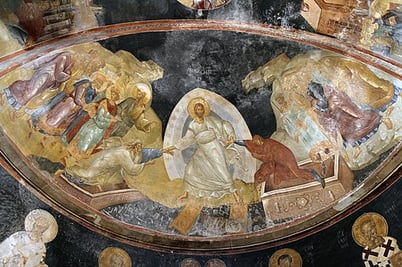 Anastasis fresco, Chora Church, Istanbul, 14th century / Till Niermann, CC BY-SA 3.0 via Wikimedia Commons
Anastasis fresco, Chora Church, Istanbul, 14th century / Till Niermann, CC BY-SA 3.0 via Wikimedia Commons
For ancient mathematicians, this “almond” shape indicated a fusion of essences or natures—a melding of perfections. (Circles, after all, are potent symbols of eternity and perfection, having no superfluous parts and no beginning or end.) In light of this ancient understanding, we can see the “mandorla” of the resurrected Jesus as proclaiming the now-glorified union of Christ’s two natures: divine and human. In this single, potent symbol, early Christian artists could evoke both radiating majesty and the wonderful paradox of the Incarnation in its fulfilled and perfected form. Consequently, while “mandorla” symbols were at first most common in Resurrection imagery, they soon came to be used in other contexts as well to signify redemption and hope. Sometimes, for example, images of the Virgin Mary as the vessel of the Incarnation are enclosed in a mandorla (the miraculous Virgin of Guadalupe is a famous example, connecting the traditional mandorla with the Aztec sun deity). In addition, Liturgical vestments are sometimes ornamented with a mandorla surrounding the monogram of Christ.
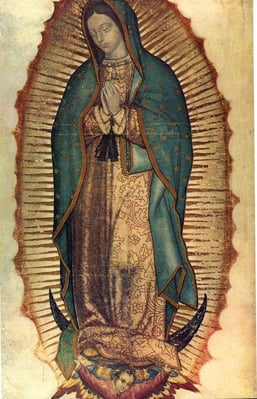 Our Lady of Guadalupe, Mexico, 16th century / Public domain via Wikimedia Commons
Our Lady of Guadalupe, Mexico, 16th century / Public domain via Wikimedia Commons
The Perfect Circle and the Ouroboros
There is one celebrated image of Christ’s resurrection that transforms the traditional mandorla into a perfect circle. In Matthias Grunewald’s famous Isenheim Altarpiece, created around 1516, the resurrected Christ hovers serenely before a molten orb, its penumbra seeming to glitter with solar flares. Here, there are no points and no sense of a Venn diagram. There is just glowing, eternal perfection, swelling into a white light at its upper center where Christ’s face gleams with radiance. Why did Grunewald modify the mandorla? Does His image lose its ancient sense of nature, combining and transforming Christ into something superhuman and solely divine?
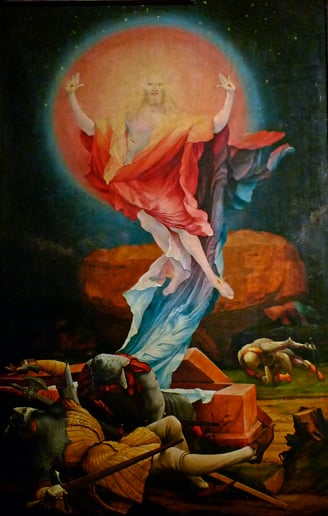 Matthias Grunewald, The Resurrection, ca. 1515 / Unterlinden Museum, Public domain, via Wikimedia Commons
Matthias Grunewald, The Resurrection, ca. 1515 / Unterlinden Museum, Public domain, via Wikimedia Commons
I don’t think so. In his massive, virtuosic altarpiece, now housed in a museum in Colmar, France, Grunewald made sure to stress both the human and divine natures of Jesus. The most famous image on the altarpiece, in fact, is the image that appears when the structure’s doors are closed: it is a Crucifixion and one of the most harrowing and visceral Crucifixions in all of the world art. Here, in empathetic relation to sufferers of skin diseases (a major audience for this altarpiece), a pock-marked, green-hued, contorted Christ hangs dead on His cross, flagrantly human, mortal, and vulnerable. Elsewhere on the altarpiece, saints like Sebastian (shot through with arrows) and Anthony (an ascetic in the desert) suffer their own torments of the flesh. And in a central panel behind the open doors, Grunewald gives the Nativity pride of place, specifically emphasizing Christ’s birth from a human woman and his participation in human processes (suggested flagrantly by a chamberpot!). It is in this context of fleshly birth, embodied travail, and painful death that Grunewald’s resurrection image should be understood. The perfect circle contains but does not erase, all the “human nature” that has come before it.
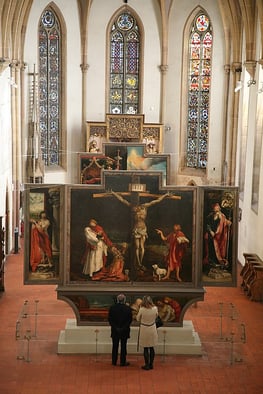 Matthias Grunewald, Isenheim Altarpiece (showing disassembled layers), ca. 1515 / vincent desjardins, CC BY 2.0 via Wikimedia Commons
Matthias Grunewald, Isenheim Altarpiece (showing disassembled layers), ca. 1515 / vincent desjardins, CC BY 2.0 via Wikimedia Commons
And fittingly, the blazing light of Grunewald’s circle does not obscure Christ’s resurrection wounds. In fact, the white-hot glow of the sun-like orb serves to highlight the red marks in Jesus’s hands. They pulse red against the circle’s glow, almost more visible than in any earlier rendering of the scene.
For Pythagoras, the circle indicated simple, eternal perfection. But for many other ancient peoples, including the people of ancient Greece, Egypt, and Scandinavia, the circle was also linked to the ouroboros—or the serpent eating its own tail. The ouroboros connoted eternity, yes—but also birth, change, death, and rebirth. It combined endless perfection with the earthly life cycle and the cycle of the seasons. In Grunewald’s ingenious altarpiece, then, we see both the human and divine natures of Jesus evoked in a new but potent and convincing way.
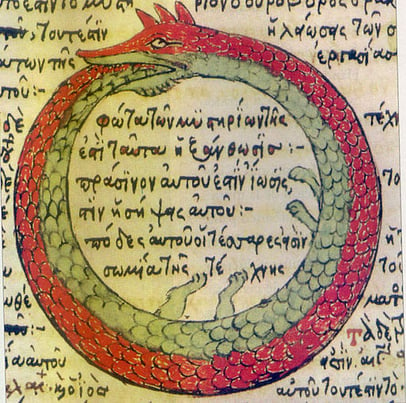 Ouroboros, 15th c. alchemical manuscript /anonymous medieval illuminator; uploader Carlos adanero, Public domain via Wikimedia Commons
Ouroboros, 15th c. alchemical manuscript /anonymous medieval illuminator; uploader Carlos adanero, Public domain via Wikimedia Commons
Grunewald’s Resurrection and the Eucharist
There is perhaps one final resonance with Grunewald’s gleaming, pale circle around the resurrected Christ—and that is the Eucharist itself. By Grunewald’s time, Christians were accustomed to seeing the Eucharistic wafer displayed in splendid monstrances—circular display cases—during the Mass. One type of monstrance is the “solar” monstrance, which surrounds the pale, white Eucharistic wafer with golden rays like those of the sun.
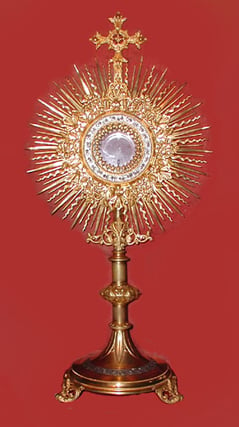 “Solar” monstrance / Broederhugo, CC BY-SA 3.0 via Wikimedia Commons
“Solar” monstrance / Broederhugo, CC BY-SA 3.0 via Wikimedia Commons
Naturally, the sun has been an important symbol of life in practically all ancient cultures. In fact, when the maverick Egyptian pharaoh Akhenaten declared, around 1300 B.C., that there was only one God (contradicting traditional Egyptian polytheism), he identified that God with the sun. Meanwhile, among pagan Romans adapting to the Christian worldview, Christ was sometimes connected to Sol Invictus: “the sun, unconquered.” A famous mosaic from the Vatican necropolis (where St. Peter is buried) attests to this fact. We have already seen, meanwhile, how the miraculous Guadalupe image of early Mexico appropriated the rays of the local sun god.
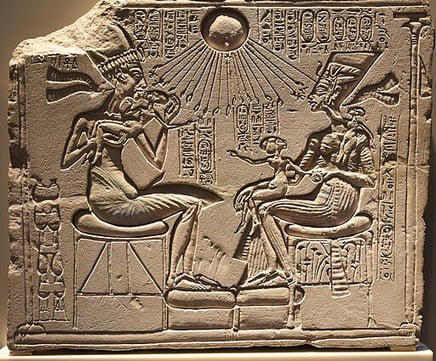 Akhenaten, Nefertiti and Their Three Daughters, Egypt, ca. 1300 BC / Richard Mortel from Riyadh, Saudi Arabia, CC BY 2.0 via Wikimedia Commons
Akhenaten, Nefertiti and Their Three Daughters, Egypt, ca. 1300 BC / Richard Mortel from Riyadh, Saudi Arabia, CC BY 2.0 via Wikimedia Commons
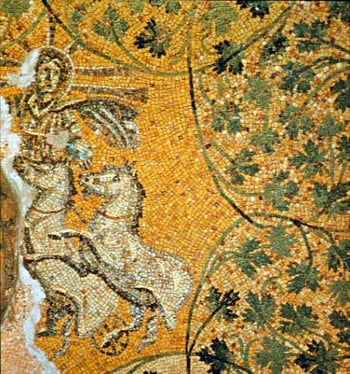 Christ as “Sol Invictus,” Vatican Necropolis, 3rd c. AD / Public domain, via Wikimedia Commons
Christ as “Sol Invictus,” Vatican Necropolis, 3rd c. AD / Public domain, via Wikimedia Commons
In Grunewald’s resurrected Christ, then, there are resonances of ancient sun symbolism, Pythagorean circular perfection and the growing devotion to Eucharistic adoration in late medieval Europe. Jesus Christ is shown to be the fulfillment, at once, of ancient myth, philosophical speculation, historical prophecy, and the earthy desires of “ordinary” folk. This is the “true myth,” once and for all, toward which all art, history, mysticism, and reason authentically point. In simple images of a man inscribed in a circle (or square), Christian artists could speak universally to every open heart.
**Cover image: Anastasis fresco, Chora Church, Istanbul, 14th century / Till Niermann, CC BY-SA 3.0 via Wikimedia Commons / altered to 1700x850

